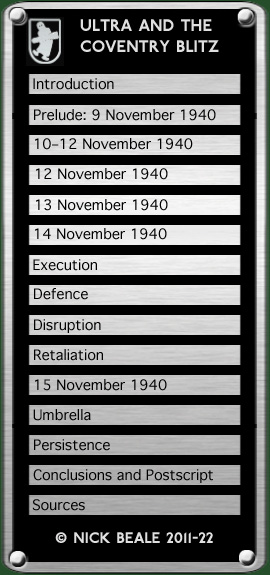|
In a subsequent Hut 3 paper, these deficiencies are restated and are annotated “Nothing done 20/12.” Perhaps in an attempt to goad the Air Ministry into co-operation, the paper’s author notes that by contrast: … the Admiralty makes a point of supplying the German Naval Section of GC&CS with every item of information available. The 31 December memo from Hut 3 indicates that information flowed from Bletchley to No. 80 Wing but not in the other direction. They did not know what, if anything, was done with the intelligence they produced. Bletchley also had problems of capacity and was certain that it could achieve much more if these were remedied. On 20 November an unsigned paper had lamented that: The present situation is deplorable. Our two Spiders [improved Bombes] are working continuously and do not get the constant attention that they need. They cannot even deal with Red and Brown [Luftwaffe ciphers], so the Naval work is at a standstill.
… we are practically dependent on Bombes for results [and] it appears that we need at least 5 for current Air and Army traffic and 1 spare. This accounts for all 6 now in [sic] order. Any lingering suggestion that Coventry (or Birmingham for that matter) was “sacrificed” to protect Ultra does not survive examination of the evidence. Ultra gave no unambiguous warning of the date or target of Moonlight Sonata; the city’s defences were nevertheless strengthened but could not prevail against over 400 attackers. Also, a range of counter-offensive measures was set in train in an attempt to degrade the German night bomber force’s effectiveness. On a clear night with the moon near full it is likely that, beams or no beams, Luftwaffe crews would have found Coventry, if not specific targets within it. As was understood at the time, once fires had been started then following waves no longer needed electronic guidance. In fact Air Scientific Intelligence was able to interpret events as proving the success of Radio Counter Measures (RCM): The policy of KGr. 100 … underwent a complete change from accurate blind bombing to fire-raising consequent upon the defeat of Knickebein. The Coventry raid of 14/15.11.40 was the first result of this new policy … sacrificing its accuracy in order to start large fires. Hermann Göring on the other hand declared to his airmen in an Order of the Day for 23 November: In the last few nights I have assigned you two exceptional tasks: the annihilation of the City of Coventry and of the war industry in the City of Birmingham. Both targets were of decisive importance for the war … [the enemy] will break, when we know not but break he will, of this were are certain … Be proud of all you have achieved … in [these] nerve-racking night attacks. What this story does demonstrate is that in the late autumn of 1940 the available technologies of night defence had not evolved sufficiently to take a serious toll on the attackers. Radar-directed AA guns, ground-controlled interception, radar-equipped fighters and radio countermeasures would all quickly improve. The harassment of enemy bases by night would by 1944 be a serious impediment to the Luftwaffe. So would the speed and volume of Bletchley’s decrypts and the information that could be derived from them as knowledge of enemy forces, equipment and personnel was built up.
Even in March 1944, German propaganda harked back to Coventry. Embedded with a bomber Gruppe in Italy, war correspondent Fw. Ludwig Doering lyrically evoked his hosts’ battle honours: A silvery haze lay over the airfield as they took off for Coventry on a cold November night. Operation “Moonlight Sonata” in the clearest visibility, the tender piano rising over the moonlit waves of the Channel, swelling to the fiery forte of the powerful enemy AA defence during the approach flight over the island and ringing out in a mighty crescendo of destruction over the British armament factories.
|
|||

 Fifty to sixty Spiders were urgently required if GC&CS was to achieve its potential and on the 26th the Deputy Director, Commander Edward Travis wrote:
Fifty to sixty Spiders were urgently required if GC&CS was to achieve its potential and on the 26th the Deputy Director, Commander Edward Travis wrote: